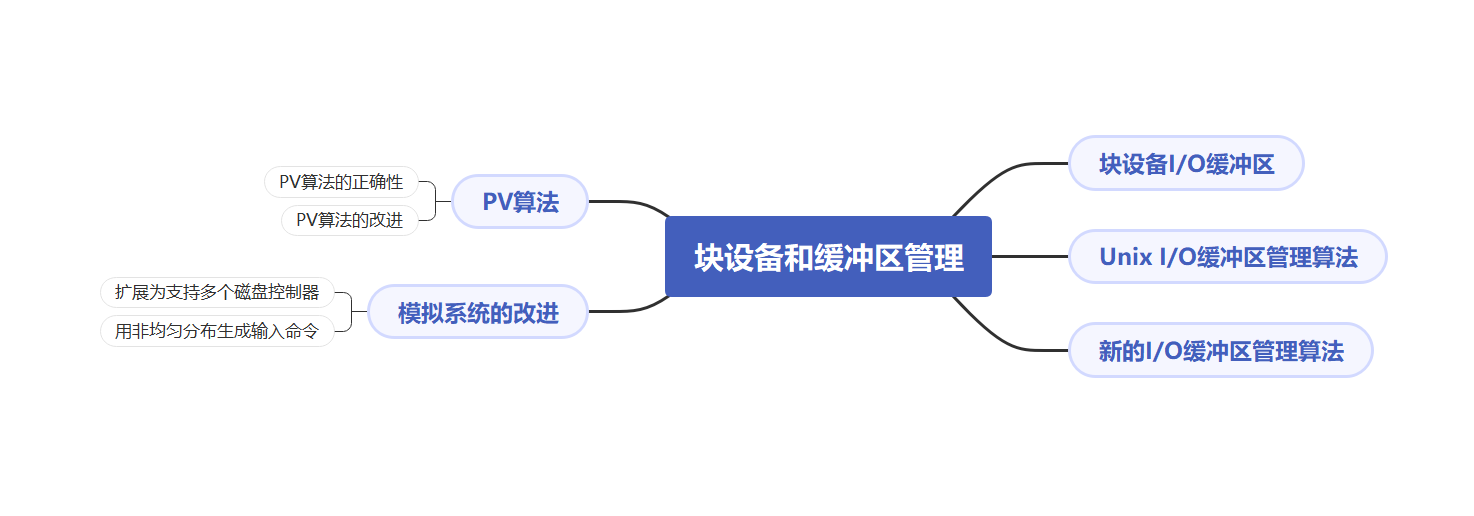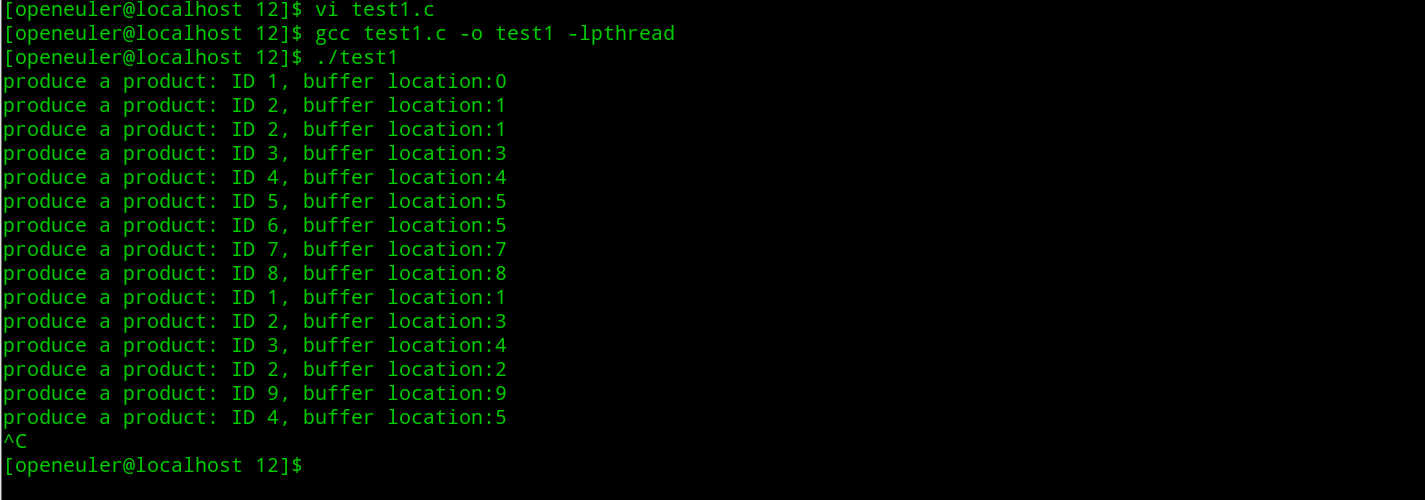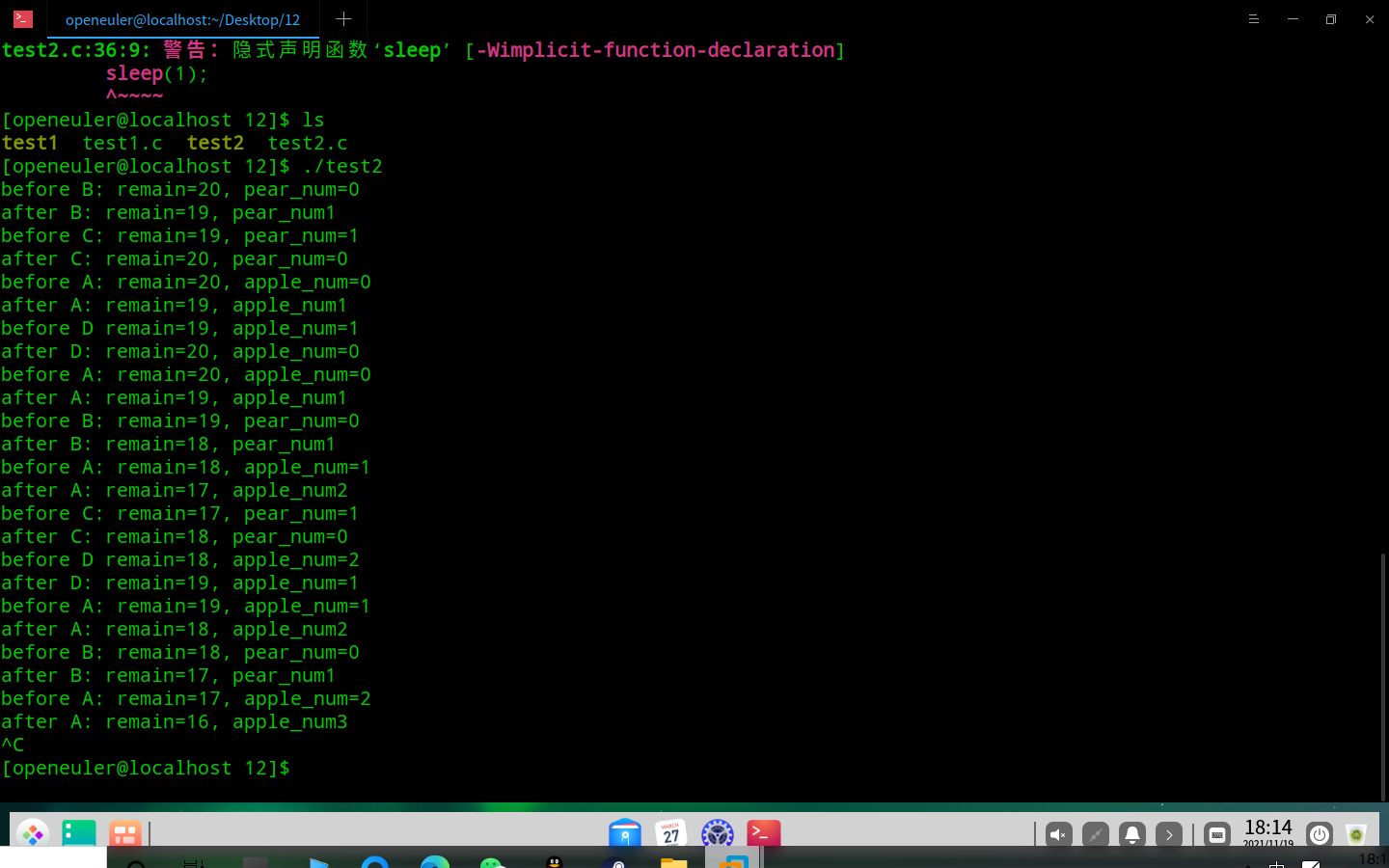《Unix/Linux系统编程》第十二章学习笔记
第十二章 块设备I/O和缓冲区管理
知识点总结

本章讨论了块设备 I/O和缓冲区管理;解释了块设备I/O的原理和I/O缓冲的优点;论述了Unix 的缓冲区管理算法,并指出了其不足之处;还利用信号量设计了新的缓冲区管理算法,以提高 I/O缓冲区的缓存效率和性能;表明了简单的PV算法易于实现,缓存效果好,不存在死锁和饥饿问题;还提出了一个比较 Unix 缓冲区管理算法和 PV算法性能的编程方案。编程项目还可以帮助读者更好地理解文件系统中的I/O操作。
块设备I/O缓冲区
I/O缓冲的基本原理非常简单。文件系统使用一系列I/O缓冲区作为块设备的缓存内存。当进程试图读取(dev,blk)标识的磁盘块时。它首先在缓冲区缓存中搜索分配给磁盘块的缓冲区。如果该缓冲区存在并且包含有效数据、那么它只需从缓冲区中读取数据、而无须再次从磁盘中读取数据块。如果该缓冲区不存在,它会为磁盘块分配一个缓冲区,将数据从磁盘读人缓冲区,然后从缓冲区读取数据。当某个块被读入时、该缓冲区将被保存在缓冲区缓存中,以供任意进程对同一个块的下一次读/写请求使用。同样,当进程写入磁盘块时,它首先会获取一个分配给该块的缓冲区。然后,它将数据写入缓冲区,将缓冲区标记为脏,以延迟写入,并将其释放到缓冲区缓存中。由于脏缓冲区包含有效的数据,因此可以使用它来满足对同一块的后续读/写请求,而不会引起实际磁盘I/O。脏缓冲区只有在被重新分配到不同的块时才会写人磁盘。
Unix I/O缓冲区管理算法
I/O缓冲区:内核中的一系列NBUF 缓冲区用作缓冲区缓存。每个缓冲区用一个结构体表示。
typdef struct buf[
struct buf*next__free;// freelist pointer
struct buf *next__dev;// dev_list pointer int dev.,blk;
// assigmed disk block;int opcode;
// READ|wRITE int dirty;
// buffer data modified
int async;
// ASYNC write flag int valid;
//buffer data valid int buay;
// buffer is in use int wanted;
// some process needs this buffer struct semaphore lock=1; /
// buffer locking semaphore; value=1
struct semaphore iodone=0;// for process to wait for I/0 completion;// block data area char buf[BLKSIZE];)
} BUFFER;
BUFFER buf[NBUF],*freelist;// NBUF buffers and free buffer list
设备表:每个块设备用一个设备表结构表示。
struct devtab{
u16 dev;
// major device number // device buffer list BUFFER *dev_list;BUFFER*io_queue
// device I/0 queue ) devtab[NDEV];
Unix算法的优点:1.数据的一致性;2.缓存效果;3.临界区;
Unix算法的缺点:1.效率低下;2.缓存效果不可预知;3.可能会出现饥饿;4.该算法使用只适用于单处理系统的休眠/唤醒操作。
PV算法:
BUFFER *getb1k(dev,blk):
while(1){
(1). P(free);
//get a free buffer first
if (bp in dev_1ist){
(2). if (bp not BUSY){
remove bp from freelist;P(bp);
// lock bp but does not wait
(3).return bp;
// bp in cache but BUSY V(free);
// give up the free buffer
(4).P(bp);
// wait in bp queue
return bp;v
// bp not in cache,try to create a bp=(dev,blk)
(5).bp = frist buffer taken out of freelist;P(bp);
// lock bp,no wait
(6).if(bp dirty){
awzite(bp);
// write bp out ASYNC,no wait
continue;
// continue from (1)
(7).reassign bp to(dev,blk);1/ mark bp data invalid,not dir return bp;-
// end of while(1);
brelse(BUFFER *bp),
{
(8).iF (bp queue has waiter)( V(bp); return; ]
(9).if(bp dirty && free queue has waiter){ awrite(bp);zeturn;}(10).enter bp into(tail of) freelist;V(bp);V(free);
}
新的I/O缓冲区管理算法
- 信号量的主要优点是:
(1)计数信号量可用来表示可用资源的数量,例如:空闲缓冲区的数量。
(2)当多个进程等待一个资源时,信号量上的V操作只会释放一个等待进程,该进程不必重试,因为它保证拥有资源。
Box#1:用户界面﹐这是模拟系统的用户界面部分,提示输人命令、显示命令执行、显示系统状态和执行结果等。在开发过程中,可以手动输入命令来执行任务。在最后测试过程中,任务应该有自己的输入命令序列 - Box#2:多任务处理系统的CPU端,模拟单处理器(单CPU)文件系统的内核模式。当系统启动时,它会创建并运行一个优先级最低的主任务,但它会创建ntask工作任务,所有任务的优先级都是1,并将它们输人readyQueue。然后,主任务执行以下代码,该代码将任务切换为从readyQueue运行工作任务。
- Box#3:磁盘控制器,它是主进程的一个子进程。因此,它与CPU端独立运行,除了它们之间的通信通道,通信通道是CPU和磁盘控制器之间的接口。通信通道由主进程和子进程之间的管道实现。
- 磁盘中断:从磁盘控制器到CPU的中断由SIGUSR1(#10)信号实现。在每次IO操作结束时,磁盘控制器会发出 kill(ppid, SIGUSR1)系统调用,向父进程发送SIGUSR1信号,充当虚拟CPU中断。通常,虚拟CPU会在临界区屏蔽出/人磁盘中断(信号)。为防止竞态条件,磁盘控制器必须要从CPU接收一个中断确认,才能再次中断。
- 虚拟磁盘:Box#4:Linux文件模拟的虚拟磁盘。使用Linux系统调用lseek()、read(和write(),支持虚拟磁盘上的任何块I/O操作。为了简单起见,将磁盘块大小设置为16字节。由于数据内容无关紧要,所以可以将它们设置为16个字符的固定序列。
实践部分
点击查看代码
include <stdio.h>
#include <pthread.h>
#include <stdlib.h>
#include <unistd.h>
#define N 100
#define true 1
#define producerNum 10
#define consumerNum 5
#define sleepTime 1000
typedef int semaphore;
typedef int item;
item buffer[N] = {0};
int in = 0;
int out = 0;
int proCount = 0;
semaphore mutex = 1, empty = N, full = 0, proCmutex = 1;
void * producer(void * a){
while(true){
while(proCmutex <= 0);
proCmutex--;
proCount++;
printf("produce a product: ID %d, buffer location:%d\n",proCount,in);
proCmutex++;
while(empty <= 0){
printf("buffer is full\n");
}
empty--;
while(mutex <= 0);
mutex--;
buffer[in] = proCount;
in = (in + 1) % N;
mutex++;
full++;
sleep(sleepTime);
}
}
void * consumer(void *b){
while(true){
while(full <= 0){
printf("buffer is empty\n");
}
full--;
while(mutex <= 0);
mutex--;
int nextc = buffer[out];
buffer[out] = 0;//消费完将缓冲区设置为0
out = (out + 1) % N;
mutex++;
empty++;
printf("produce a product: ID %d, buffer location:%d\n", nextc,out);
sleep(sleepTime);
}
}
int main()
{
pthread_t threadPool[producerNum+consumerNum];
int i;
for(i = 0; i < producerNum; i++){
pthread_t temp;
if(pthread_create(&temp, NULL, producer, NULL) == -1){
printf("ERROR, fail to create producer%d\n", i);
exit(1);
}
threadPool[i] = temp;
}//创建生产者进程放入线程池
for(i = 0; i < consumerNum; i++){
pthread_t temp;
if(pthread_create(&temp, NULL, consumer, NULL) == -1){
printf("ERROR, fail to create consumer%d\n", i);
exit(1);
}
threadPool[i+producerNum] = temp;
}//创建消费者进程放入线程池
void * result;
for(i = 0; i < producerNum+consumerNum; i++){
if(pthread_join(threadPool[i], &result) == -1){
printf("fail to recollect\n");
exit(1);
}
}//运行线程池
return 0;
}

点击查看代码
#include <stdio.h>
#include <stdlib.h>
#include <semaphore.h>
#include <errno.h>
#define total 20
sem_t remain, apple, pear, mutex;
static unsigned int vremain = 20, vapple = 0, vpear = 0;
void *father(void *);
void *mather(void *);
void *son(void *);
void *daughter(void *);
void print_sem();
int main()
{
pthread_t fa, ma, so, da;
sem_init(&remain, 0, total);//总数初始化为20
sem_init(&apple, 0, 0);//盆子中苹果数, 开始为0
sem_init(&pear, 0, 0);//盆子中梨子数, 开始为0
sem_init(&mutex, 0, 1);//互斥锁, 初始为1
pthread_create(&fa, NULL, &father, NULL);
pthread_create(&ma, NULL, &mather, NULL);
pthread_create(&so, NULL, &son, NULL);
pthread_create(&da, NULL, &daughter, NULL);
for(;;);
}
void *father(void *arg)
{
while(1)
{
sem_wait(&remain);
sem_wait(&mutex);
printf("before A: remain=%u, apple_num=%u\n", vremain--, vapple++);
printf("after A: remain=%u, apple_num%u\n", vremain, vapple);
sem_post(&mutex);
sem_post(&apple);
sleep(1);
}
}
void *mather(void *arg)
{
while(1)
{
sem_wait(&remain);
sem_wait(&mutex);
printf("before B: remain=%u, pear_num=%u\n", vremain--, vpear++);
printf("after B: remain=%u, pear_num%u\n", vremain, vpear);
sem_post(&mutex);
sem_post(&pear);
sleep(2);
}
}
void *son(void *arg)
{
while(1)
{
sem_wait(&pear);
sem_wait(&mutex);
printf("before C: remain=%u, pear_num=%u\n", vremain++, vpear--);
printf("after C: remain=%u, pear_num=%u\n", vremain, vpear);
sem_post(&mutex);
sem_post(&remain);
sleep(3);
}
}
void *daughter(void *arg)
{
while(1)
{
sem_wait(&apple);
sem_wait(&mutex);
printf("before D remain=%u, apple_num=%u\n", vremain++, vapple--);
printf("after D: remain=%u, apple_num=%u\n", vremain, vapple);
sem_post(&mutex);
sem_post(&remain);
sleep(3);
}
}
void print_sem()
{
int val1, val2, val3;
sem_getvalue(&remain, &val1);
sem_getvalue(&apple, &val2);
sem_getvalue(&pear, &val3);
printf("Semaphore: remain:%d, apple:%d, pear:%d\n", val1, val2, val3);
}

问:setbuf()函数和setvbuf()函数的区别是什么?
答:setbuf()和setvbuf()函数的实际意义在于:用户打开一个文件后,可以建立自己的文件缓冲区,而不必使用fopen()函数打开文件时设定的默认缓冲区。这样就可以让用户自己来控制缓冲区,包括改变缓冲区大小、定时刷新缓冲区、改变缓冲区类型、删除流中默认的缓冲区、为不带缓冲区的流开辟缓冲区等。
https://www.jb51.net/article/71720.htm

